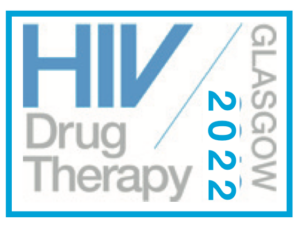Glasgow 2022: doravirine updates
1 February 2023. Related: Conference reports, Antiretrovirals, HIV 16 Glasgow 2022.
Kirk Taylor, HIV i-Base
 Glasgow 2022 included several studies on antivirals for the treatment and prevention of HIV.
Glasgow 2022 included several studies on antivirals for the treatment and prevention of HIV.
Studies included updates on metabolic and safety data for doravirine (DOR) and real-world data on DOR use. In addition, a novel maturation inhibitor, phase 2 data on a broadly neutralising antibody (bNAb) therapy and long-acting PrEP were discussed.
Phase 3 studies of DOR report weight gain of ≥5% for 106 participants (23%). [1] Increased risk was noted for people living with HIV that had previously used an NRTI or PI.
An Italian study of the metabolic and safety profile of DOR noted reduced levels of ALT for people on DOR vs RPV. [2]
Real-world data on the DOR use and its efficacy in a UK study reported 94% retention and 95% viral suppression at six months. [3]
Metabolic factors and use of doravirine in real-world settings
Weight gain has been reported on several trials of DOR-containing regimens. Median weight gains for DRIVE-FORWARD, DRIVE-AHEAD and DRIVE-SHIFT were +1.9 kg, +2.0 kg and +1.4 kg, respectively. [1] The majority of participants (70%) on phase 3 studies experienced weight gain of <5%. However, 23% of participants (n=106) enrolled on DRIVE-FORWARD and DRIVE-AHEAD had ≥5% weight gain. Increased risk of weight gain was noted for females and those with previous PI or NRTI use. Further data are required to understand the mechanisms and demographics associated with weight gain on DOR-containing regimens.
A further study evaluated the metabolic and safety profile associated with switch to DOR vs RPV in people living with HIV. [2] Participants were female (29%), Caucasian (91%) and median age was 53.6 ± 12.4 years for those on DOR (n=128) and 42.3 ± 9.3 years for those on RPV (n=331). Lipid levels were reduced for both groups of participants but liver enzymes (ALT; alanine transaminase) were lower for people that switched to DOR.
The DRIVE-REAL cohort was established to evaluate the real-world implementation and efficacy of DOR-containing regimens. [3] Participants (n=249) were Black (14%), Asian (2%) and 77% were aged ≥40. Two thirds of participants had co-morbidities that included depression (26%), hyperlipidaemia (19%), anxiety (13%) and hypertension (12%).
At six months, 94% of participants continued to use DOR and 95% had undetectable viral load (<50 copies/mL). These data represent the largest real-world assessment of DOR use in the UK and reported efficacy is comparable to data from phase 3 studies.
References
Please notes that due to website problems on the conference website, links below are to NATAP.org.
- Orkin C et al. Factors associated with weight loss or stable weight after continuing or switching to a doravirine-based regimen. HIV Drug Therapy Glasgow, October 23-26, 2022. Poster abstract P153.
https://www.natap.org/2022/Glascow/GLASGOW_49.htm
https://hivglasgow.org/wp-content/uploads/2023/01/P153_Lyo_June.pdf (poster) - Maggi P et al. Metabolic and hepatic safety in ART experienced PLWH switching to a DOR-based regimen vs rilpivirine. Data from a real-life setting. HIV Drug Therapy Glasgow, October 23-26, 2022. Poster abstract P066.
https://www.natap.org/2022/Glascow/GLASGOW_48.htm
https://hivglasgow.org/wp-content/uploads/2023/01/P066_Squillace_Nicola.pdf (poster) - O’Halloran C. Real world utilisation of doravirine among people living with HIV in England (DRIVE-REAL). HIV Drug Therapy Glasgow, October 23-26, 2022. Poster abstract P126.
https://www.natap.org/2022/Glascow/GLASGOW_06.htm
https://hivglasgow.org/wp-content/uploads/2023/01/P126_OHalloran.pptx (poster)

